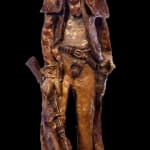

Gib Singleton
Texas Ranger
Bronze
Available as:
14" Book Edition of 300 (18x6x6)
33" Edition of 25 (33x12x12)
79" Edition of 25 (79x28x22)
14" Book Edition of 300 (18x6x6)
33" Edition of 25 (33x12x12)
79" Edition of 25 (79x28x22)
The Rangers got their start in 1823 when Stephen F. Austin received permission from the Mexican government (Tejas was then a Mexican state) to enlist 10 men to range along...
The Rangers got their start in 1823 when Stephen F. Austin received permission from the Mexican government (Tejas was then a Mexican state) to enlist 10 men to range along the frontiers and scout for hostiles. He offered SIS a month in land fo their services. "Texas was pretty rough back then,' Gib said. 'Most of the northwest was Comancheria (the traditional homeland of the Comanche peoples) and they didn't l too kindly on a bunch of settlers claiming their land and hunting their game.' The Comanche were famous for their ability to fight from horseback, move lor distances at high speed, and live off the harsh landscape. A new kind of fighter was necessary to stand up to them, and that was the Ranger. 'They rode and fought and thought like Indians,' Gib said. 'It was the only way.'
Rangers were a colorful lot, sporting monikers like 'Alligator' Davis, 'Bigfoot' Wallace and 'Old Paint Caldwell. They were almost all in their 20s and most of them lived hard and died young. 'Life expectancy in that outfit was maybe two years, Gib said. 'If the Indians didn't get you, the snakes or the flash floods or the blizzards would. Or the bar fights.'
The Rangers rode sturdy plains ponies, and in the early days, most carried multiple single-shot pistols and muskets. 'They were usually way outnumbered, Gib said, 'and a Comanche could get off a dozen arrows in the time it took a Ranger to reload one weapon. It wasn't until Sam Colt brought out his revolver that the Rangers could match the firepower of the Comanche.
'It was a pretty loose outfit, and these guys didn't worry about a lot of rules,' Gib said. 'They elected their own officers based on ability - especially the ability to win battles without losing a bunch of their own guys. And they fought in whatever was comfortable. They'd wear buckskins or buffalo robes. Maybe Mexican serapes, or just leggings and a loincloth like the Comanche.' In addition to fighting Indians, Rangers fought and died at the Alamo, and also with Zachary Taylor in the invasion of Mexico. The high speed, mobile warfare they learned fighting the Comanche later became the basis for tactics of both Union and Confederate cavalries in the Civil War. That's really when cavalry went from fighting on horseback to using horses to get to the battlefield and fighting on foot,' Gib said. 'Bedford Forrest. Buford. Sheridan. The good commanders all learned from the Rangers.'
While the Rangers were mostly successful in fending off Comanche raids, it was the arrival of European diseases such as smallpox, and the destruction of the buffalo herds, that ended the struggle. Not long after the Civil War, when the U.S. Army came back west, the Rangers were disbanded as a military force. In the 20th century, the name was applied to the investigative unit of the Texas Department of Public Safety.
-JOHN GOEKLER
Rangers were a colorful lot, sporting monikers like 'Alligator' Davis, 'Bigfoot' Wallace and 'Old Paint Caldwell. They were almost all in their 20s and most of them lived hard and died young. 'Life expectancy in that outfit was maybe two years, Gib said. 'If the Indians didn't get you, the snakes or the flash floods or the blizzards would. Or the bar fights.'
The Rangers rode sturdy plains ponies, and in the early days, most carried multiple single-shot pistols and muskets. 'They were usually way outnumbered, Gib said, 'and a Comanche could get off a dozen arrows in the time it took a Ranger to reload one weapon. It wasn't until Sam Colt brought out his revolver that the Rangers could match the firepower of the Comanche.
'It was a pretty loose outfit, and these guys didn't worry about a lot of rules,' Gib said. 'They elected their own officers based on ability - especially the ability to win battles without losing a bunch of their own guys. And they fought in whatever was comfortable. They'd wear buckskins or buffalo robes. Maybe Mexican serapes, or just leggings and a loincloth like the Comanche.' In addition to fighting Indians, Rangers fought and died at the Alamo, and also with Zachary Taylor in the invasion of Mexico. The high speed, mobile warfare they learned fighting the Comanche later became the basis for tactics of both Union and Confederate cavalries in the Civil War. That's really when cavalry went from fighting on horseback to using horses to get to the battlefield and fighting on foot,' Gib said. 'Bedford Forrest. Buford. Sheridan. The good commanders all learned from the Rangers.'
While the Rangers were mostly successful in fending off Comanche raids, it was the arrival of European diseases such as smallpox, and the destruction of the buffalo herds, that ended the struggle. Not long after the Civil War, when the U.S. Army came back west, the Rangers were disbanded as a military force. In the 20th century, the name was applied to the investigative unit of the Texas Department of Public Safety.
-JOHN GOEKLER

